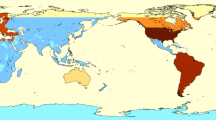Abstract
The Defense Mapping Agency (DMA) and NASA/Goddard Space Flight Center (GSFC) are currently involved in the development of a global gravity model complete to degree and order 360. This effort requires the compilation of a worldwide set of 30’x30’ surface mean free-air gravity anomalies. The extensive data archive at DMA is the main source of gravity information from which the 30’ mean values are estimated. New sources of terrestrial gravity data used in the model will include the former Soviet Union, Greenland, South America, Africa, Southeast Asia, Antarctica, and the Arctic. Improvements to current terrestrial sources have been made in North America, Europe, and Australia. However, several areas have been identified which are still lacking detailed and accurate gravity information and emphasize the need to intensify data collection efforts. Substantial effort is made to ensure accurate and consistent processing of the point gravity anomaly data used in the estimation of the 30’ mean values. This effort is aimed at producing a global set of mean values with significantly reduced long wavelength systematic errors. The mean values and their accuracies are estimated using least-squares collocation and remove-restore techniques implemented at DMA. For the reduction process, consistent 1’ and 5’ elevation databases were compiled by DMA and GSFC using the best worldwide elevation sources currently available. This paper describes the data being used in the project and the computational procedures being implemented.
Preview
Unable to display preview. Download preview PDF.
Similar content being viewed by others
References
Forsberg, R., A New Covariance Model for Inertia, Gravimetry and Gradiometry, J. Geophys. Res., 92, B2, 1305–1310, 1987.
Forsberg, R., A Study of Terrain Reductions, Density Anomalies and Geophysical Inversion Methods in Gravity Field Modeling, Dept. of Geod. Sci. and Surv. Rep. 355, Ohio State Univ., Columbus, 1984.
Heck, B., An evaluation of some systematic error sources affecting terrestrial gravity anomalies, Bull. Geod., 64, 88–108, 1990.
Heiskanen, W.A. and H. Moritz, Physical Geodesy, W.H. Freeman, San Francisco, 1967.
Moritz, H., Advanced Physical Geodesy, Herbert Wichmann Verlag, Karlsruhe, 1980.
Nerem, R.S., et al., Gravity model development for TOPEX/POSEIDON: Joint Gravity Models 1 and 2, J. Geophys. Res., 99, 24421–24447, 1994.
Pavlis, N.K. and R.H. Rapp, The development of an isostatic gravitational model to degree 360 and its use in global gravity modeling, Geophys. J. Int., 100, 369–378, 1990.
Rapp, R.H. and N.K. Pavlis, The development and analysis of geopotential coefficient models to spherical harmonic degree 360, J. Geophys. Res., 95, 21885–21911, 1990.
Rapp, R.H., Y.M. Wang and N.K. Pavlis, The Ohio State 1991 geopotential and sea surface topography harmonic coefficient models, Dept. of Geod. Sci. and Surv. Rep. 410, Ohio State Univ., Columbus, 1991.
Row, L.W., D.A. Hastings and P.K. Dunbar, TerrainBase Worldwide Digital Terrain Data, National Geophysical Data Center, Boulder, Colorado, April 1995.
Tscherning, C.C. and R.H. Rapp, Closed covariance expressions for gravity anomalies, geoid undulations, and deflections of the vertical implied by degree-variance models, Dept. of Geod. Sci. Rep. 208, Ohio State Univ., Columbus, 1974.
Uotila, U.A., Computation of Mean Anomalies of 1° × 1° Blocks, Dept. of Geod. Sci. Rep. 95, Ohio State Univ., Columbus, 1967.
Author information
Authors and Affiliations
Editor information
Editors and Affiliations
Rights and permissions
Copyright information
© 1996 Springer-Verlag Berlin Heidelberg
About this paper
Cite this paper
Kenyon, S.C., Pavlis, N.K. (1996). The Development of a Global Surface Gravity Data Base to be Used in the Joint DMA/GSFC Geopotential Model. In: Rapp, R.H., Cazenave, A.A., Nerem, R.S. (eds) Global Gravity Field and Its Temporal Variations. International Association of Geodesy Symposia, vol 116. Springer, Berlin, Heidelberg. https://doi.org/10.1007/978-3-642-61140-7_9
Download citation
DOI: https://doi.org/10.1007/978-3-642-61140-7_9
Publisher Name: Springer, Berlin, Heidelberg
Print ISBN: 978-3-540-60882-0
Online ISBN: 978-3-642-61140-7
eBook Packages: Springer Book Archive




